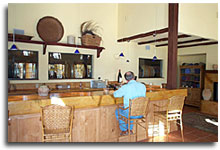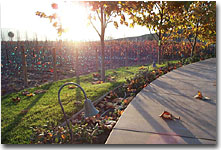
Melville Vineyards
by Eric Anderson
photos courtesy of: Michael Poston
(excerpted from Vol.8 No.6, Journal du Vin, November 2000. Michael Poston and I paid a visit on 11/26/00 to Melville Vnyds in Lompoc for a tour and tasting.)
Details
This recently
established winery (tasting room opened July 2000) is located right next
door to Babcock, on Hwy 246. Situated on a small hill just off the highway,
the Tuscan-inspired  villa
that serves as both the winery as well as the beautifully appointed tasting
room, is an immediate attention grabber. The property looks great too,
with vineyards filling the space between the road and the winery.
villa
that serves as both the winery as well as the beautifully appointed tasting
room, is an immediate attention grabber. The property looks great too,
with vineyards filling the space between the road and the winery.
The Melville family brings past experience to their new venture here in the western Santa Ynez Valley. Previously, Ron Melville and family were operating a successful grape growing business in Calistoga, farming the usual Chardonnay, Merlot and Cabernet Sauvignon. The quality of their fruit was excellent, and much of it found its way into the reserve wines of Geyser Peak, Dry Creek Vineyards, and Chateau St. Jean -- no small feat. Deciding to relocate the family, yet continue in the grape growing business, Ron selected an 82 acre location in Lompoc, and began to pursue his interest in Pinot Noir. Recently, the project took on additional emphasis, and Ron, along with sons, Brent and Chad, became not only growers of high quality Pinot Noir, but also decided to become winemakers as well. Their 1999 debut vintage includes a Santa Maria and an Estate Pinot, as well as a Santa Rita Hills Chardonnay. A miniscule amount of Estate '99 Syrah (23 cases) was released December 1, 2000.
Melville
currently has 75 acres under vine on the property, distributed to produce
about 55% Pinot Noir, 30% Syrah, and 15% Chardonnay. In 1998, they added
another 55-60 acres (of the 100 owned) in Cat Canyon (near Los Alamos). The Melvilles have planted 11 clones of Pinot
Noir in mostly sandy and loamy soil (with some clay), as well as 3 clones
of Chardonnay, and 7 clones of Syrah, on 5 different rootstocks. Although
currently augmenting the fruit from outside sources while waiting for
maturity of their vines, intentions call for Melville to become Estate-only
with the 2000 vintage. Aside from their own production, the Melville fruit
is largely committed to other local wineries: Brewer-Clifton, Babcock,
Jaffurs, Santa Barbara Winery, Lane Tanner, and Ojai. Ron selected Greg
Brewer as winemaker for the label, given Greg's stellar reputation and
familiarity with Santa Barbara County fruit. Brewer, formerly of Santa
Barbara Winery, also has his own Brewer-Clifton label, which is now utilizing
the Melville facility as well.
Canyon (near Los Alamos). The Melvilles have planted 11 clones of Pinot
Noir in mostly sandy and loamy soil (with some clay), as well as 3 clones
of Chardonnay, and 7 clones of Syrah, on 5 different rootstocks. Although
currently augmenting the fruit from outside sources while waiting for
maturity of their vines, intentions call for Melville to become Estate-only
with the 2000 vintage. Aside from their own production, the Melville fruit
is largely committed to other local wineries: Brewer-Clifton, Babcock,
Jaffurs, Santa Barbara Winery, Lane Tanner, and Ojai. Ron selected Greg
Brewer as winemaker for the label, given Greg's stellar reputation and
familiarity with Santa Barbara County fruit. Brewer, formerly of Santa
Barbara Winery, also has his own Brewer-Clifton label, which is now utilizing
the Melville facility as well.
...so, I stuck my head in...
 On
arriving, we first met with tasting room director, Megan Wright, who started
us out with the '99 SMV Chardonnay. Chad Melville then stepped out to
introduce himself, and after an in-depth description and tour of the grounds,
the winery, and their winemaking approach, we proceeded to "wade into"
a little barrel tasting. In expressing yields, most wineries speak in
terms of tons-per-acre from the vineyard. Given the high-density plantings,
Melville prefers to use pounds-per-vine as a way to express its yields.
In the case of the Estate Pinot, the 1/3 ton per acre translates to 1/2
lb per plant. Chad explained Melville's current and preferred method of
bin-fermenting the fruit, using extended maceration, 35% carbonic maceration,
and gravity feed to minimize handling the fruit.
On
arriving, we first met with tasting room director, Megan Wright, who started
us out with the '99 SMV Chardonnay. Chad Melville then stepped out to
introduce himself, and after an in-depth description and tour of the grounds,
the winery, and their winemaking approach, we proceeded to "wade into"
a little barrel tasting. In expressing yields, most wineries speak in
terms of tons-per-acre from the vineyard. Given the high-density plantings,
Melville prefers to use pounds-per-vine as a way to express its yields.
In the case of the Estate Pinot, the 1/3 ton per acre translates to 1/2
lb per plant. Chad explained Melville's current and preferred method of
bin-fermenting the fruit, using extended maceration, 35% carbonic maceration,
and gravity feed to minimize handling the fruit.
At one point, Chad uncovered a bin of fermenting Pinot to show us the fruit and stems "cooking." By impulse, I stuck my head into the bin I took in a big wiff -- big mistake. The huge CO2 blast felt like I was drinking 7-Up with my nose! Chad's role as Assistant Winemaker keeps him involved in the day-to-day processes with Greg, something he obviously relishes. "Wanna try the 115 clone with different levels of stems," he asked, climbing up a stack of barrels with the wine thief in hand. He seemed just as fascinated as we were at discovering the results of different techniques used for each wine. Actually, one of the really interesting things about barrel tasting is the ability to taste all of these individual raw materials -- the effects of using various clones and yeasts. This is never more obvious as with Pinot Noir. Melville also appears to have all the raw materials be very successful in this venture, and we may be witnessing a rising star.
|
|
|
All rights reserved No original material may be reproduced without written consent Mail & Comments - Eric Anderson |
||

|
||
